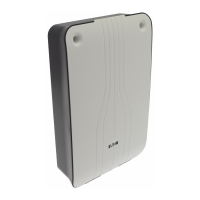
Do you have a question about the Eaton i-on30R and is the answer not in the manual?
| Zones | 30 |
|---|---|
| Users | 30 |
| Radio Frequency | 868 MHz |
| User Codes | 30 |
| Operating Temperature | -10°C to +55°C |
| Communication | Ethernet, PSTN, GSM/GPRS |
| Power Supply | 230V AC, 50Hz |
| Battery Backup | 12V 7Ah |
Details compliance with PD6662, EN50131-3, and EN50131-6 standards.
Alerts users to mains voltages inside the control unit.
Explains the purpose and scope of the user guide.
Describes system configurations for part-setting and partitioned operation.
Details how the system can be divided into separate alarm zones.
Introduces the various devices that make up the alarm system.
Describes the central processing unit of the alarm system.
Explains the function of detectors and how they are assigned to zones.
Covers how the system communicates alarms via sounders, ARC, or SMS.
Details how system outputs control external equipment.
Describes the role and features of keypads in system interaction.
Explains how proximity tags are used for system identification.
Details the use of one-way and two-way remote controls.
Describes the function of HUA transmitters for panic alarms.
Explains different user types like Master, Admin, and Normal users.
Details access codes, their management, and lockout procedures.
Covers installer access and the SecureConnect remote monitoring feature.
Explains the concepts of setting and unsetting the alarm system.
Details how to set and unset the system using keypads.
Describes the quick-setting feature for arming the system.
Covers using two-way remote controls for system control.
How to set, unset, and query system status with a two-way remote.
Initiating a panic alarm using a two-way remote control.
Details using one-way remote controls for system arming/disarming.
Procedures for arming and disarming the system with one-way remotes.
Explains how to use one-way radio keypads to set/unset the system.
Disarming with radio keypads and controlling the system via SMS.
Lists different alarm types and their corresponding sounds.
Describes additional actions the system takes during an alarm.
Details how pre-recorded speech messages are used and acknowledged.
Procedures for managing active alarms.
Explains installer resets and how to handle accidental alarms.
How to check for system alerts like low battery or faults.
Provides a map of user menu options by user type.
Steps to access and leave the user menu interface.
How to input text and characters using the keypad.
Explains how to temporarily exclude zones from being armed.
Describes shunting zones as an alternative to omitting them.
How users can manage shunt groups to affect zone arming.
Procedures for adding new users and modifying existing ones.
Steps for removing users and their associated devices.
How to access and interpret the system's event history.
Explains the unique numbering system for different user actions.
Overview of system testing procedures.
How to test the alarm system's audio output devices.
Procedure for testing the functionality of wired keypads.
Guide on testing detectors without triggering a full alarm.
How to test user-defined outputs like lights or locks.
Procedure for verifying the operation of remote controls.
How to test radio Hold Up Alarm devices.
Procedure for verifying the functionality of proximity tags.
How to test the connection to Alarm Receiving Centres.
Overview of settings adjustable within the system configuration menu.
How to enable or disable system features like chime and remote access.
Instructions for adjusting the system's date and time settings.
How to schedule system events like arming/disarming.
Procedures for managing programmed calendar events and exceptions.
How users can postpone scheduled system setting events.
How to set up contact details for outgoing messages.
Steps to modify recipient names, phone numbers, and email addresses.
How to configure user-defined outputs like lights or locks.
Options for editing, deleting, and managing remote controls.
How to assign specific functions to remote control buttons.
How to control remote unsetting capabilities for security.
Procedures for removing lost or reassigned remote controls.
How to manage the Hold-Up Alarm function for remote controls.
How to initiate a connection for system configuration via software.
Manual control of system outputs like lights or locks.
Accessing system information like model, version, and mode.
Steps to create a code for pairing the SecureConnect app.